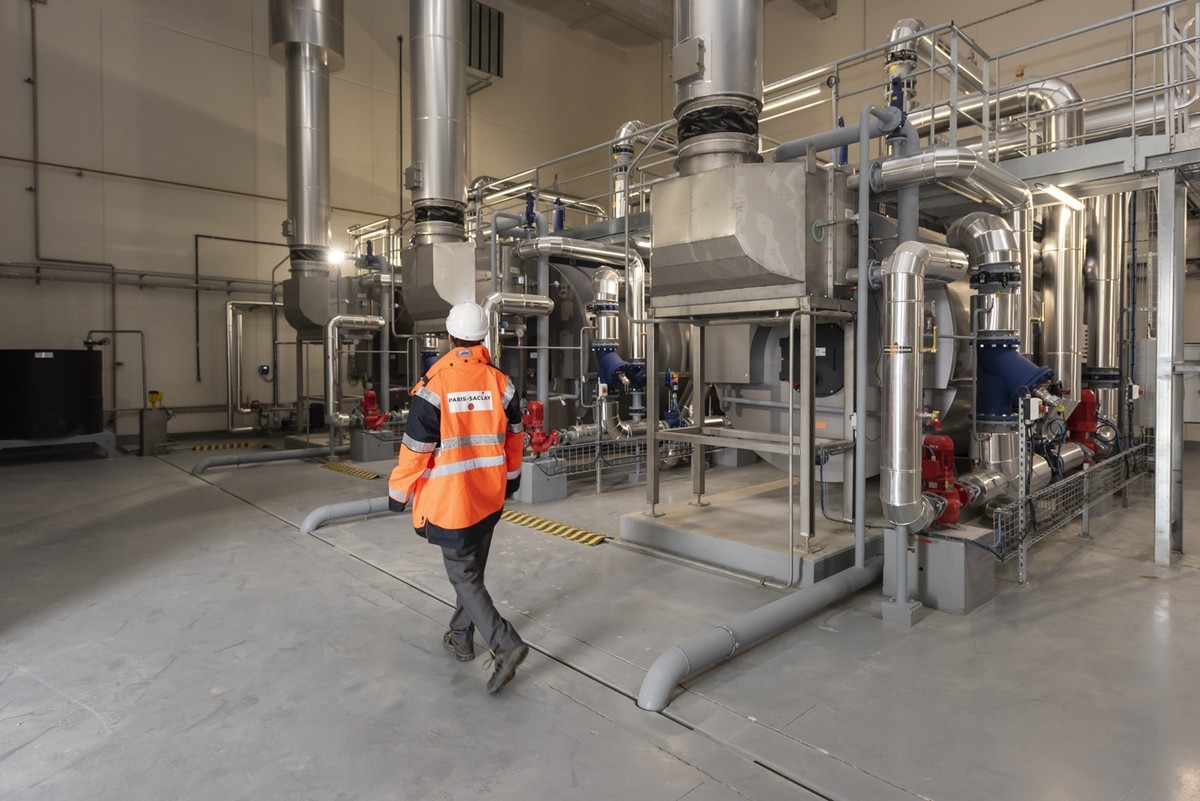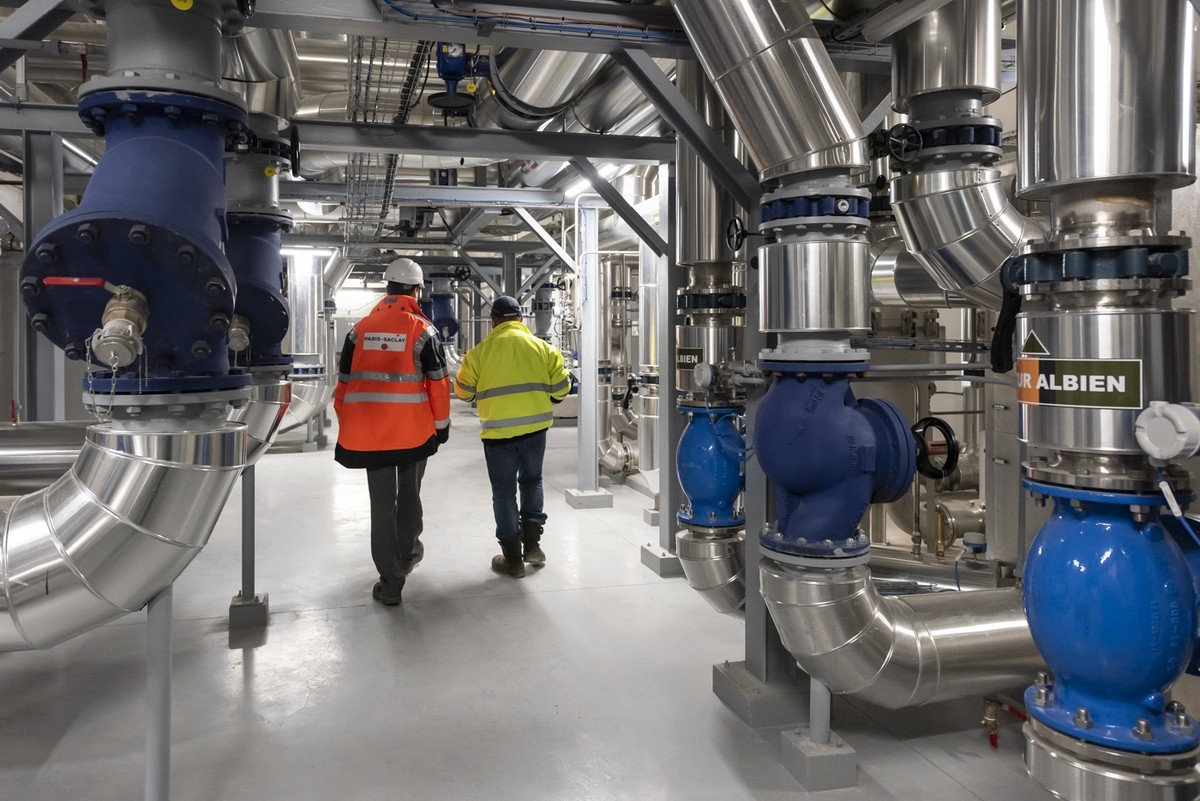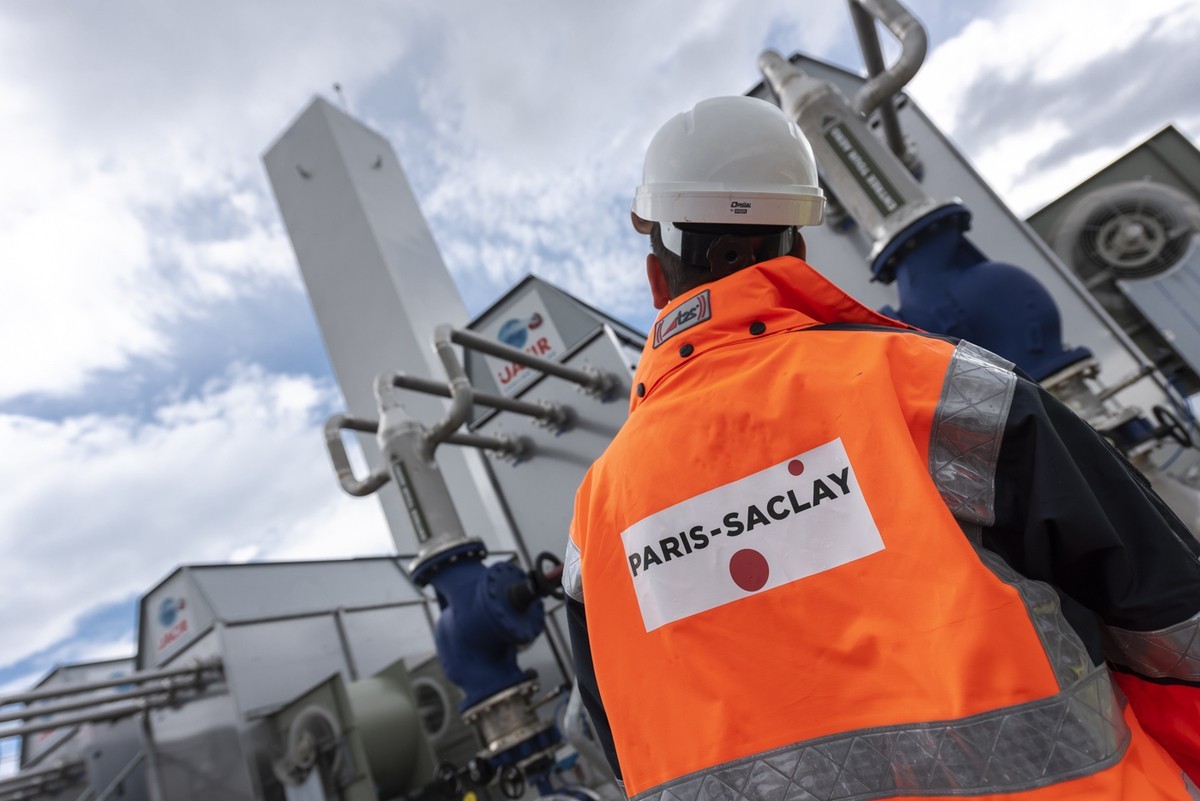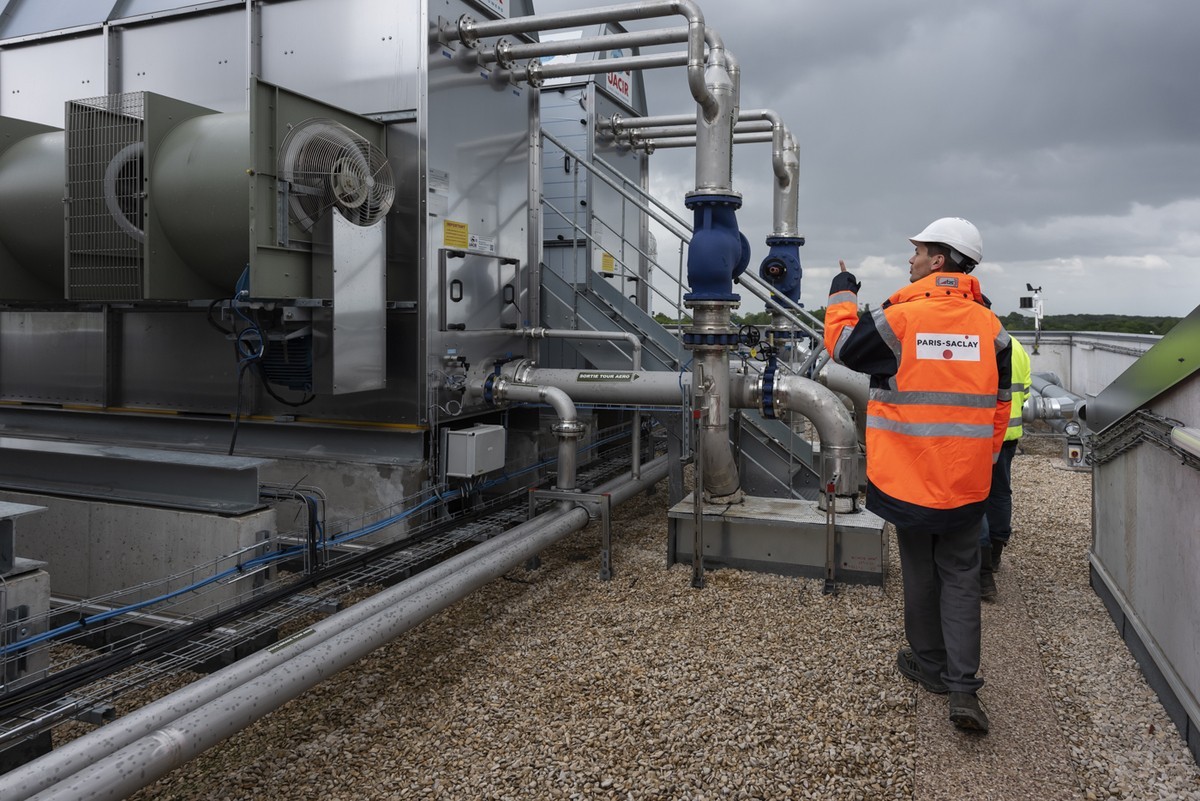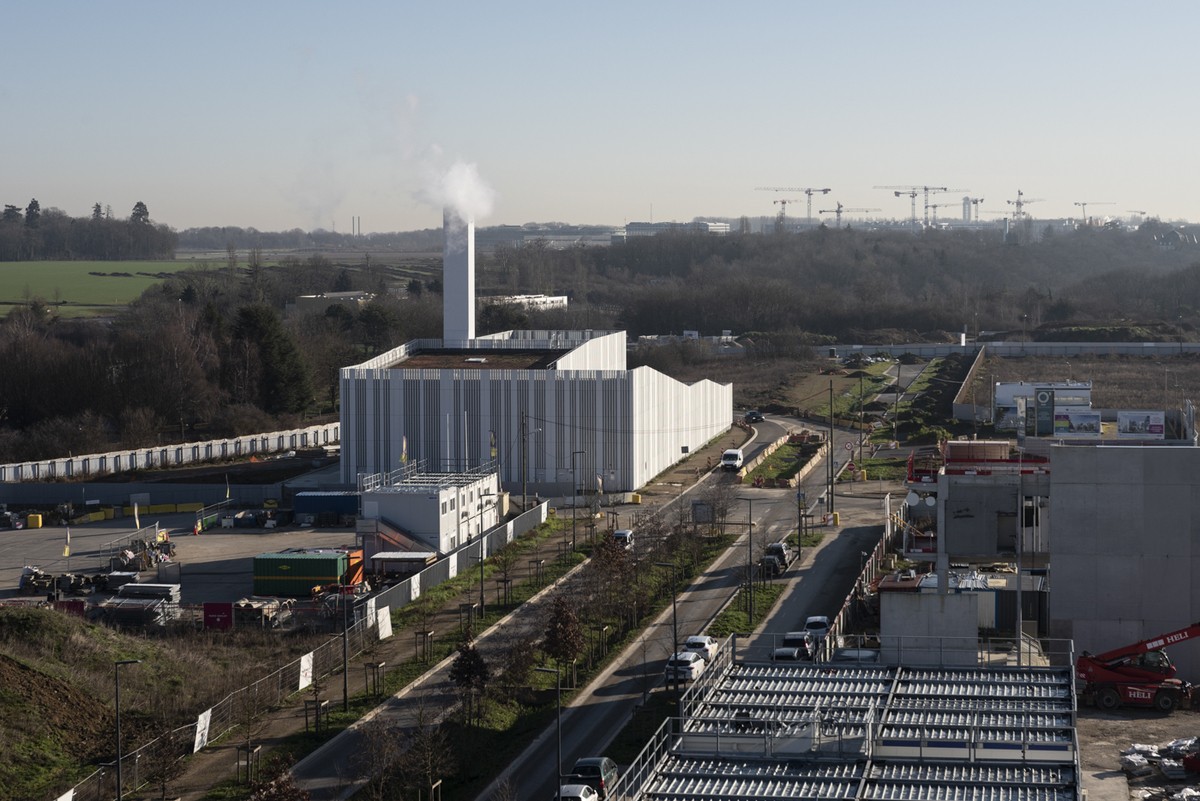The 5th generation heating and cooling grid of Paris-Saclay
Last modified by the author on 09/06/2022 - 15:17
- Year of commitment : 2019
- Address 1 - street : 6 Boulevard Dubreuil 91400 ORSAY, France
- CO2 Impact : *
- Green energies : Energy production, Energy Distribution, Energy storage, Photovoltaic solar, Geothermal, Recovering of fatal energy, Energy Efficiency, Electricity, Cool, Heat
- Digital services : Data & Network, Data centers, Smart metering, Smart grid, Automation
- Circular economy and waste management : Circular economy, Production, Waste Recycling, Optimization of ressources, Save of ressources
-
50 000 000 €
- Builder
IDEX, EGIS - Manager / Dealer
Etablissement Public d'Aménagement Paris-Saclay
EPA Paris-Saclay, the public authority in charge of land use planning in the Paris-Saclay agglomeration, is responsible for the development of a world-class technology and innovation cluster. As such, the Paris-Saclay district heating and cooling grid, which is one of the most innovative district heating and cooling grids in Europe, is the cornerstone of this energy strategy, while also serving as a demonstrator for the European D2Grids project.
In figures
- A 12 km network
- 650,000 m2 housing units connected, representing more than 50 MW of cumulative heating and cooling capacity.
- An objective of 50% of the energy used is renewable and recovered, allowing the production of heat that is mainly carbon-free.
- 24 / 24 The grid is controlled automatically, 24 hours a day, 365 days a year.
- 1st time that a heating and cooling exchange of urban scale is built in France on a temperate loop.
- 1 of the 5 European demonstrators of the 5th generation grids (5GDHC) in the framework of the Interreg NWE D2Grids project.
- Target to 25km of network running discreetly under public roads
- Target:: 2 000 000 m^2 connected to the grid: more than 50 MW of power combining heat and cold
The context of the project
The development of the Paris-Saclay urban campus is an opportunity to implement the new governance recommended by the law on energy transition for green growth while meeting the objectives set by the COP21. This ambition is reflected locally by the adoption of a low-energy, low-carbon model that involves working jointly on the performance of new buildings, the renovation of existing buildings and the in situ production of renewable energy. The creation of the Paris-Saclay heating and cooling grid is part of this dynamic. It is based on the use of geothermal energy, a local and clean source of heat, as well as on the recovery of heat from the cooling of buildings with specific cooling needs.
A European pilot site for 5th generation grids
The Paris-Saclay heating and cooling exchange grid is a demonstrator of 5th generation energy networks (5GDHC) in the framework of the European Interreg NWE D2Grids project.
Lasting 3 years (2018-2022), it aims to accelerate the deployment of 5th generation district heating and cooling.
A 5th generation district heating and cooling grid (5GDHC) is based on the exchange of thermal energy between buildings with different needs. The main grid transports a low temperature flow to active and distributed substations that raise the temperature to the required level. Distributed thermal storage buffers the fluctuation of heat and cooling supply and demand. This architecture maximizes the share of renewable energy sources and low-grade residues.
Using this process, the EPA Paris-Saclay has equipped several student residences with advanced energy demand management systems, making it possible to smooth out peaks in heat consumption on the grid and increase the share of renewable energy.
See the "Sustainable Solutions" section at the end of this case study to learn more about 5GDHC grids
Strengthening synergies between electrical uses and heating and cooling
In response to the 2nd Interreg NWE call for capitalization, the social housing compay Seqens has joined the new D2GRIDS project consortium dedicated to a better integration of electrical uses and local renewable energy production capacities.
Seqens is carrying out an innovative project of collective self-consumption photovoltaic electricity coupled with the 5th generation heating network;
The ambitions are as follows:
- To improve its new housing stock through more efficient buildings
- Produce and consume renewable energy thanks to photovoltaic panels and the 5th generation heating and cooling network
- Generate energy savings for its tenants by using part of the electricity produced in the common areas of the housing units and selling the other part to the operator of the EPAPS 5th generation heating grid.
The results of the feasibility studies produced with Greenflex and LLC Avocats show a production of 59,000 kWh / year of green electricity (equivalent to the consumption of 12 households) distributed as follows
- Approximately 30% for the common areas of the social housing,
- Approximately 70% sold directly to the operator of the EPAPS 5th generation heating and cooling network
This economic model, balanced over the duration of the operation, allows to generate revenues in order to ensure the sustainability of the system and its replicability.
These results will be confirmed when the photovoltaic installations are commissioned once the buildings are delivered in 2024.
Progress Status
Delivered
Data Reliability
Self-declared
Funding Type
Public
Website Enterprise / Infrastructure
https://epa-paris-saclay.fr/nos-missions/amenager-durablement/le-reseau-dechange-de-chaleur-et-de-froid-de-paris-saclay-un-modele-innovant-au-service-de-la-transition-energetique/https://5gdhc.eu/project-cases/paris-saclay/
https://www.construction21.org/france/data/sources/users/18704/20220823090909-jrc12377120210211studyonsustainabledhcjrctiliavf4.pdf
Sustainable Development
- From 2023, the tempered loop will recover heat from the Jean Zay supercomputer.
- Other heat recovery projects are under study, including heat from the Synchrotron Soleil, a particle gas pedal located in Paris-Saclay that produces synchrotron radiation, an extremely bright light that allows exploration of inert or living matter;
- Part of the electrical supply for the Paris-Saclay heating and cooling network will also be provided by self-consumption of photovoltaic electricity produced on the roofs of the urban campus.
Testimony / Feedback
Interview with Nicolas Eyraud, "Heating and cooling grid" project director in the innovation strategy department, EPA Paris-Saclay, June 2020
How is this heating and cooling grid different?
NE-The Urban Campus heating and cooling grid participates in the Smart Energy Paris-Saclay intelligent multi-energy network. On this scale, it is a world first which will be done in connection with industrialists but also through research partnerships with institutions present in the territory.
How is it innovative?
NE-The fact that this network connects together buildings that are themselves extremely efficient and that it opens up prospects for virtuous energy management and scientific cooperation make it one of the main technological demonstrators in France.
Since when is the Albian aquifer an energy resource?
NE-This aquifer has been used on several occasions, in particular by a borehole in Orsay dug a century ago, and much more recently to supply heating grids in Issy-les-Moulineaux and on the ZAC Clichy-Batignolles for example. The exploitable underground surface of this aquifer occupies a large part of the western half of Île-de-France.
(...)
Governance
- 10 million by ADEME
- 1.5 million by D2Grids out of the 2.5 million for the demonstrators
- The rest is financed by the EPA, which finances the rest by paying the costs applied to the subscribers (over approximately 20 years): half in connection fees paid by each builder who connects his building(s) to the network and the other half in the share of subscriptions paid by the consumers.
Etablissement Public d'Aménagement Paris-Saclay
Publicly Owned Development Corporation
IDEX, EGIS
Natural Ressources Manager
Etablissement Public d'Aménagement Paris-Saclay
Public
To implement this heating and cooling grid, EPA Paris-Saclay signed a CREM (Design, Build, Operate and Maintain) contract in 2015 with the Idex group and, as a subcontractor, a consortium composed of Idex Energies and Egis. This seven-year contract allows for the adjustment of technical and financial aspects in coordination with the scientific institutions and companies that will be involved. This upstream interaction is essential for the design of buildings and districts, and for achieving optimal environmental and economic performance. During the design and construction phase of the network, the State and the local authorities, through EPA Paris-Saclay, have complete control over the project (scope, technical solutions, connection costs and energy prices). EPA Paris-Saclay is the guarantor of the defence of common interests ensuring the performance and feasibility of the network on the one hand and the interests of the users on the other.
The technical solution proposed by Idex responded effectively to the specifications of the consultation, bringing a significant innovation, while remaining within the financial envelope provided by the EPA Paris-Saclay: during peaks in demand for heat in winter, the tempered water loop rises in temperature, which makes it possible to centralize the gas back-up in a single boiler room for each district and leads to savings for the heating network and for the subscribers.
The total investment for the heating network is estimated at €56 million:
Sustainable Solutions
- Renewable energies
- SmartGrids
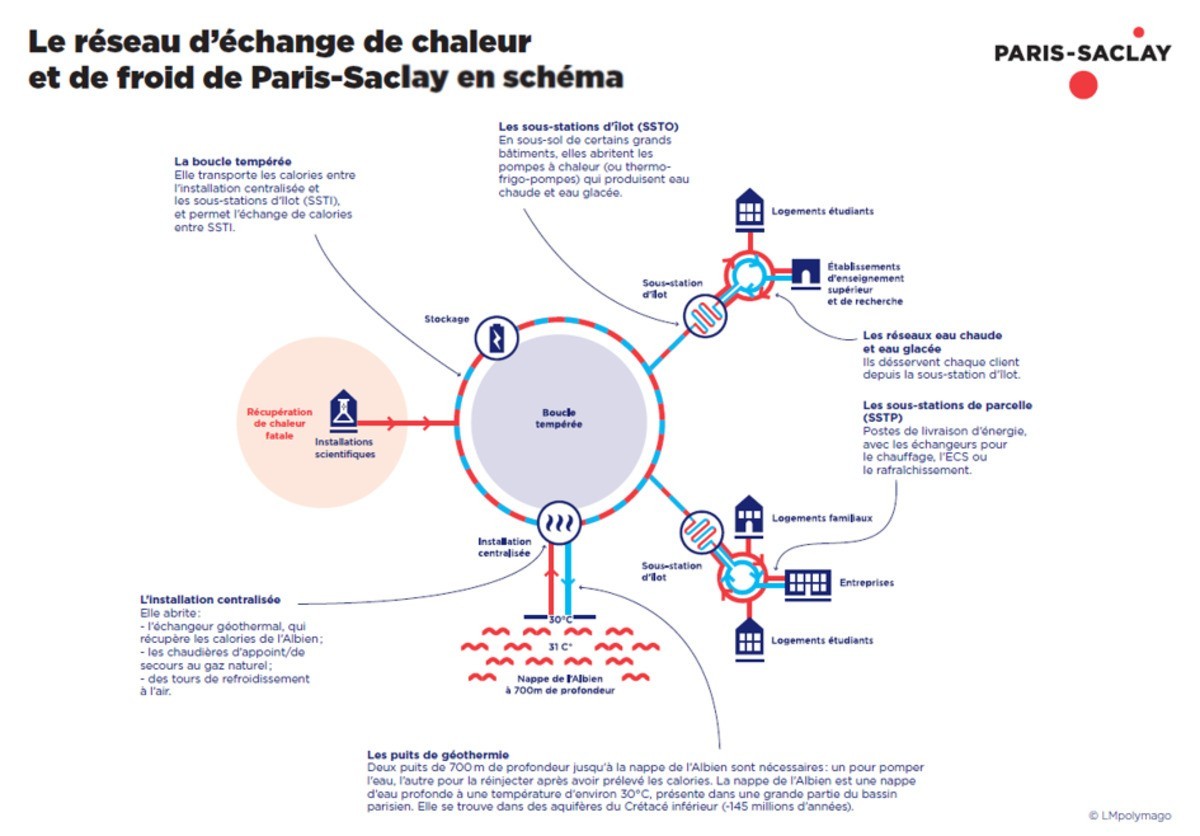
5GDHC technology:
The 5 principles of 5GDHC
5GDHC grids are smart energy networks based on a local low temperature loop and decentralized production from local renewable energies. This loop allows the exchange of energy between buildings thanks to heat pumps located on the users' premises.
In order to ensure a flexible and resilient energy network to meet current and future needs, a 5th generation heating and cooling system (5GDHC) is established on the following five principles
A closed energy loop
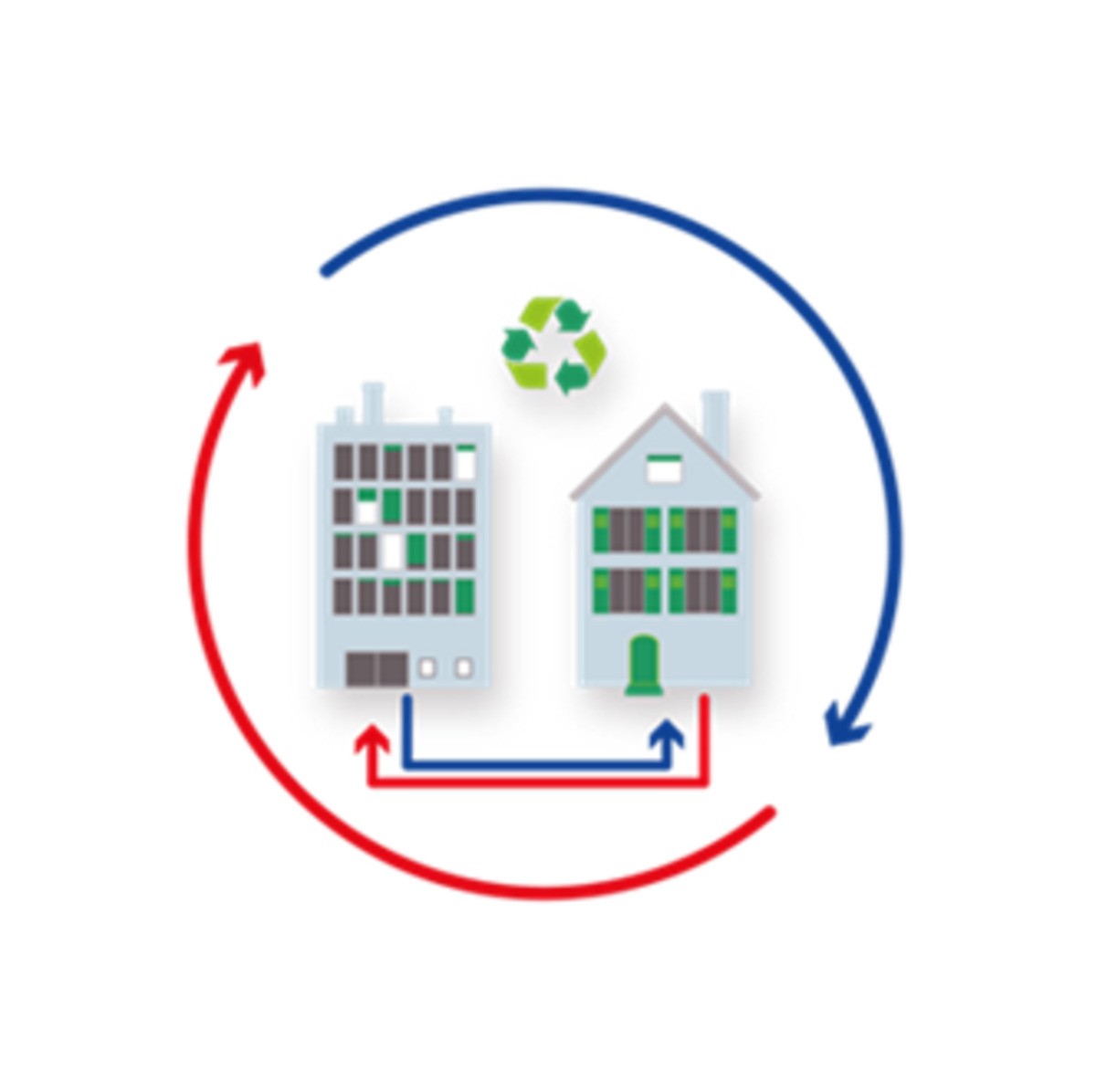
The first principle of 5GDHC is to avoid wasting energy in the system. A 5th generation grid differs from other heat and cooling grids in its ability to exchange energy with other connected consumers/customers: it is a circular thermal network. The network is designed as a closed loop reusing energy as much as possible: the heated buildings provide cold to the system, while the cooled buildings transmit their excess heat to the network.
The key factor in the 5GDHC approach is the optimal reuse of return flows at different spatial and temporal scales. Energy storage is used to manage the temporal imbalance between supply and demand within the system on a daily, but also seasonal basis.
For example, we often find heat pumps in green buildings to generate the required temperatures. These heat pumps use outdoor air, surface water or soil. On the one hand, this requires investments in source facilities that also need space, which could be an obstacle. On the other hand, some of the energy produced is lost to the surrounding environment. In 5GDHC, the back end of these heat pumps is connected to the grid and thus the return flow of energy is retained in the circuit.
This first principle of 5GDHC is implemented in a stepwise approach, exchanging energy first within a building or block, then at the neighborhood level, and finally at the city level. Further optimization of the grid would also be possible through optimized territorial planning.
Making the most of low-temperature energy

Energy sources can be classified according to their applicability. One of the foundations of 5GDHC is the observation of heat and cold demand levels, in order to bring only the necessary amount of energy into the network. A 5GDHC system does not need many high-temperature sources to meet most of its heating and cooling needs. This means that available low-temperature energy streams (such as shallow geothermal, industrial discharge, waste-to-energy, cooling process waste energy, wastewater, etc.) are prioritized when any additional heating or cooling not satisfied by the exchange must be provided to the system.
In order to optimize the 5GDHC, a prioritization of the types of input energy to be used was created. First, thermal energy exchanged between users will be used. Next, ambient temperature thermal sources as well as renewable sources with temperatures above the typical "hot" grid temperature. The last energy source in the ranking is thus fossil fuels.
The second principle of 5th generation district heating is therefore to match the available low temperature sources with the demand. The need for high-temperature energy is then reduced, and can then be covered 100% by renewable energies such as deep geothermal, wind, solar, hydro and biomass.
Decentralized, demand-driven energy supply

Traditional energy systems are centralized and circulate a large amount of energy that is never used.
In contrast, 5GDHC systems are "demand-driven," meaning that they only begin to produce and circulate energy when there is demand on the grid. This saves energy: it is produced only when and where it is needed. The system can simultaneously provide heating and cooling services at different temperatures and to different customers by adapting to demand.
In practice, 5GHDC enables a shift from a highly centralized energy system to a decentralized, intelligent grid of small facilities close to the end user.
An integrated approach to energy flows

Many energy systems contain siloed incentives: they do not optimize needs across systems and sectors. For example, a building owner powered by electricity that induces high peaks on the power grid may want to warm up in the morning after a nightly cutback. The use of thermal mass and thermal storage may require additional investment for the building but provide significant savings on the electrical grid. The goal of 5GDHC is to maximize the efficiency of energy delivery and use. This is made possible by an integrated approach to all other energy flows in a given territory (power grids, transport, industry, agriculture, etc.).
Indeed, huge losses in some sectors can be deployed to serve others. Large power plants that waste large amounts of cooling energy at room temperature could cover the heating demand of other buildings. Vehicles in the transportation sector also have low efficiency, losing a lot of heat, and new technologies, such as hydrogen conversion, have high heat losses. Integrating these different sectors can result in significant savings on the total energy balance.
In addition to energy savings, integrating a 5GDHC grid with an electric grid will help balance the grid and increase its flexibility. This will create smaller, more efficient energy infrastructures, requiring less equipment and operating energy. The system, with lower peak capacities, will also require less overall investment in infrastructure (pipelines, pumps, heat pumps, etc.) and reduce the capacity demanded by the power grid.
Priority to local and sustainable sources
This last principle of district heating and cooling grids is a matter of common sense: giving priority to what can be supplied locally rather than to distant thermal sources.
This priority to local sources has first of all an environmental and energy sobriety advantage: giving priority to local sources limits the energy losses linked to transport. But it is also an important economic advantage, as it encourages investment in local energy production, to the benefit of the territory in which the grid is located.
Photo credit
© Carlos Ayesta, EPA Paris-Saclay




